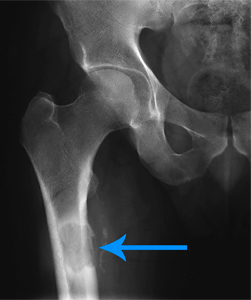
What is Metastatic Bone Disease?
Metastatic bone disease is a form of cancer that originates elsewhere in the body and spreads to the bone. It is more common than primary bone cancer which originates in the bone. This condition commonly affects the thigh bone, pelvic bone, and spine.
Causes of Metastatic Bone Disease
Although the exact cause is unclear, it is possible that mutations to the DNA of cells in some parts of the body may cause them to grow uncontrollably and form tumors. A few cancer cells break off from these tumors and travel to the bone where they multiply and cause metastatic bone disease.
Risk Factors for Metastatic Bone Disease
Many types of cancers can spread to the bone. The most common ones with high risk for bone metastasis are:
- Breast Cancer
- Prostate Cancer
- Lung Cancer
- Kidney Cancer
- Lymphoma
- Multiple myeloma
Symptoms of Metastatic Bone Disease
Common signs and symptoms of metastatic bone disease include:
- Bone or joint pain
- Fracture due to low-energy trauma
- Incontinence of bowel and bladder
- Decreased mobility and weakness in the affected limb
- Elevated blood calcium levels
Diagnosis of Metastatic Bone Disease
Diagnosis of metastatic bone disease is done by:
- Physical Exam: This is done to evaluate your signs and symptoms.
- Imaging Studies: These include X-rays and bone scans to identify bone abnormalities, MRI scans to identify connective tissue abnormalities; CT scans, PET scans, and bone scans to look for cancer in other parts of the body.
- Biopsy: A sample of the tumor may be obtained to view under a microscope to confirm the diagnosis.
Treatment of Metastatic Bone Disease
The treatment options for metastatic bone disease include:
- Surgery: Surgical excision is performed to remove the tumor completely or as much as possible without injury to important nerves, blood vessels, and organs.
- Radiation Therapy: This involves the use of high-energy beams or material to destroy cancer cells that cannot be surgically removed.
- Chemotherapy: This involves the use of special chemicals or drugs to destroy cancer cells.
- Hormone Therapy: Hormone blocking treatments may be effective against a metastatic bone disease that develops from breast and prostate cancers which are sensitive to the action of hormones.
- Targeted Therapy: This involves the use of drugs that specifically target any weakness in the cancer cells minimizing damage to healthy tissue.
- Ablation Therapy: This involves the use of electricity, cold liquid, or ultrasound waves to destroy the cancer cells.
- Bone-Building Medications: These drugs can be administered intravenously every few weeks to strengthen bone, reduce bone pain, and minimize the risk of new bone metastasis.
Prognosis for Metastatic Bone Disease
Cancer that spreads to the bone is a very serious condition; however, advancements in cancer management have made it possible to significantly improve the quality of life in patients diagnosed with metastatic bone disease. Early diagnosis, prompt treatment, and follow-up care are essential for the best prognosis.

